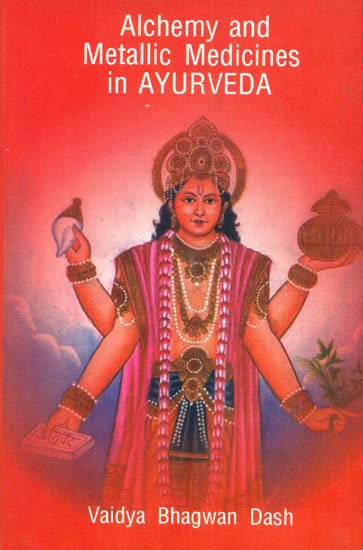Alchemy and Metallic Medicines in Ayurveda
author: Vaidya Bhagwan Dash
edition: 2003, Concept Publishing Company
pages: 236
ISBN-10: 8170220777
ISBN-13: 9788170220770
Topic: Rasashastra
Introduction
Drugs used in Ayurveda can be broadly classified into three categories, viz., (a) vegetable products, (b) animals products, and (c) metals and minerals. In the Vedic literature and in auyurvedic classics, mostly vegetable drugs were prescribed for the treatment of different categories of ailments. Very few animals products and still fewer metals and minerals are described in those texts. Metals described in these works include iron, copper, gold, lead, tin, silver and copper pyrite. They were meant for both external and internal uses. In ayurvedic classics, mercury is also prescribed for external use. Metals for internal use were processed by impregnating with different kinds of decoctions as well as the juice of herbs, and thereafter, by drying in sun or shade. These metals were then reduced to a fine power from by grinding in a mortar and pestle, and administered to the patient either alone or in combination with several other drugs. Making a bhasma or in combination with several other drugs. Marking a bhasma or calcined power of these metals was not very popular among the physicians of those days.
During the fifth century B.C. and thereafter, the important branch of Ayurveda namely salya tantra was viewed as a form of himsa or violence. Ahimsa or non-violence was the cardinal rule of the religion prevalent in those days. The religion which was adopted by the rulers and subjects alike, discouraged the practice of surgery and it was almost legally banned. This created a new problem. Some surgical conditions were, no doubt, amenable to the conventional remedies, mostly of vegetable products which were used in the practice at that time. Some special therapies like panca karma wehich include emetic therapy (vamana karma), purgation therapy (niruha and anuvasana karmas) and inhalation on therapy (nasya karma)took care of some of these obstinate surgical conditions. But the practice of these therapies were also discouraged and later banned in the areas influenced by those religious leaders. At that time, physicians as well as other research workers took upon themselves the responsibility of developing medicines for the treatment of these obstinate surgical conditions and otherwise incurable diseases.
In the forefront of this adventure were the Buddhist monks. Compassion for all living beings was an essential part for their teaching and practice. Medical care was one of their esteemed methods for the propagation of religion. Above all, it is the propounders and followers of Buddhism who banned or discouraged the salya tantra or surgery and the practice of panca karma therapies. Therefore, they endeavoured to find alternatives for curing these obstinate surgical conditions. This provided an impetus to the progress of Rasa sastra or the science dealing with therapeutic use of mercury and other metals. As a by-product, the science dealing with the transmutation of base metals into noble metals like god with the help of processed mercury also received impetus. Nagarjuna, the Buddhist philosopher and propounder of the madhyamika sect of Buddhism was in the forefront of these physicians. Notwithstanding the controversy regarding the identity and period of Nagarjuna, it can be safely stated that metals were processed and extensively used therapeutically in bhasma from prior to 3rd century A.D. Books composed on this subjected by Nagarjuna are mostly not available. Some book, authorship of Descriptive texts, now available o Rasa sastra, were mostly composed during 8th century A.D. and thereafter.
